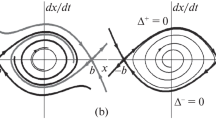Abstract
Transversal homoclinic orbits of maps are known to generate a Cantor set on which a power of the map conjugates to the Bernoulli shift on two symbols. This conjugacy may be regarded as a coding map, which for example assigns to a homoclinic symbol sequence a point in the Cantor set that lies on a homoclinic orbit of the map with a prescribed number of humps. In this paper we develop a numerical method for evaluating the conjugacy at periodic and homoclinic symbol sequences in a systematic way. The approach combines our previous method for computing the primary homoclinic orbit with the constructive proof of Smale's theorem given by Palmer. It is shown that the resulting nonlinear systems are well conditioned uniformly with respect to the characteristic length of the symbol sequence and that Newton's method converges uniformly too when started at a proper pseudo orbit. For the homoclinic symbol sequences an error analysis is given. The method works in arbitrary dimensions and it is illustrated by examples.
Similar content being viewed by others
References
E. L. Allgower and K. Georg, NumericalContinuation Methods: An Introduction, Springer Series in Computational Mathematics 13 (Springer, Berlin, 1990).
W.-J. Beyn and J.-M. Kleinkauf, The numerical computation of homoclinic orbits for maps, preprint 95–012, SFB 343, Bielefeld (1995). To appear in SIAM J. Numer. Anal.
K. Deimling,Multivalued Differential Equations, De Gruyter Series in Nonlinear Analysis and Applications 1 (de Gruyter, Berlin, 1992).
J. K. Hale and X.-B. Lin, Symbolic dynamics and nonlinearsemiflows, Ann. Mat. Pura Appl. 144 (1986) 229–259.
A. J. Homburg, On the computation of hyperbolic sets and theirinvariant manifolds, preprint No. 68, Institut für Angewandte Analysis und Stochastik, Berlin (1993).
J. M. Ortega and W. C. Rheinboldt, Iterative Solution of Nonlinear Equations in Several Variables (Academic Press, New York, 1970).
J. Palis and F. Takens, Hyperbolicity and Sensitive ChaoticDynamics at Homoclinic Bifurcation (Cambridge Univ. Press, Cambridge, 1993).
K. J. Palmer, Exponentialdichotomies, the shadowing lemma and transversal homoclinic points, in: Dynamics Reported I, eds. U. Kirchgraber and H.-O. Walther (Teubner, Stuttgart, 1988) pp. 265–306.
L. P. Shil'nikov, On a Poincaré-Birkhoff problem, Math. USSR-Sb. 3 (1967) 353–371.
S. Smale,Differentiable dynamical systems, Bull. Amer. Math. Soc. 73 (1967) 747–817.
H. Steinlein and H.-O. Walther,Hyperbolic sets, transversal homoclinic trajectories, and symbolic dynamics for C1-maps in Banach spaces, J. Dyn. Diff. Eqs. 3 (1990) 325–365.
G. Vainikko, Funktionalanalysisder Diskretisierungsmethoden (Teubner, Leipzig, 1976).
Author information
Authors and Affiliations
Rights and permissions
About this article
Cite this article
Beyn, WJ., Kleinkauf, JM. Numerical approximation of homoclinic chaos. Numerical Algorithms 14, 25–53 (1997). https://doi.org/10.1023/A:1019196426363
Issue Date:
DOI: https://doi.org/10.1023/A:1019196426363



